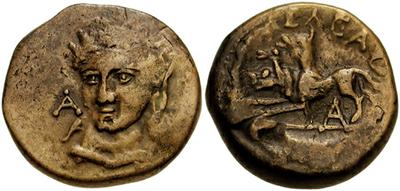SO 478 - Elea over uncertain mint: Difference between revisions
From SILVER
No edit summary |
No edit summary |
||
| Line 16: | Line 16: | ||
|Diameter=20 | |Diameter=20 | ||
|Coin reference=https://www.acsearch.info/search.html?id=156874 | |Coin reference=https://www.acsearch.info/search.html?id=156874 | ||
|Coin series reference=SNG Copenhagen/Sylloge Nummorum Graecorum: The Royal Collection of coins and medals, Danish National Museum (43 vols), 1942-1979, no. 49;Franke 1961, no. 7-20 | |Coin series reference=SNG Copenhagen/Sylloge Nummorum Graecorum: The Royal Collection of coins and medals, Danish National Museum (43 vols), 1942-1979, no. 49;Franke 1961, no. 7-20; HGC 3.1, n°238 | ||
|Overstruck reverse description=Head of Herakles, wearing lion skin. | |Overstruck reverse description=Head of Herakles, wearing lion skin. | ||
}} | }} | ||
Revision as of 17:46, 18 April 2024
342 BCE - 338 BCE | EΛEA
Images
Overstriking coin

Elea_Demeter_Kerberos.jpg [1]
Location/history
| Sale(s)Sale(s) ᵖ: | Triton 7 (12/01/2004 ), no. 185; Münzen und Medaillen Liste 192 (08/1959), no. 24. | |
Overstriking coin
Description
| ObverseInscription or printing placed on the obverse.: | Head of Persephone facing, turned slightly left, wearing grain wreath. In left field, A. | ReverseInscription or printing placed on the reverse.: | EΛEA (Greek) Kerberos left. Below, A. |
Mint and issuing power
| MintIdentifies the place of manufacture or issue of a numismatic object.: | Elea | Ancient regionAncient region. | Epirus | Modern countryModern country: Greece | AuthorityIdentifies the issuing power. The authority can be "pretended" when the name or the portrait of X is on the coin but he/she was not the issuing power. It can also be "uncertain" when there is no mention of X on the coin but he/she was the issuing power according to the historical sources: |
Chronology
| FromIdentifies the initial date in a range assigned in a numismatic context. 342 BCE toIdentifies the final date in a range assigned in a numismatic context.. 338 BCE | Classical 480-323 BC |
Physical description
| MetalThe physical material (usually metal) from which an object is made.: Bronze |
WeightWeight of the numismatic object (in grams). in grams: 7.987.98 g <br />7,980 mg <br /> | ||
| DiameterDescribes diameter of an object (in mm).: 2020 mm <br />2 cm <br /> | |||
References
| Coin referenceReference of the Coin: | https://www.acsearch.info/search.html?id=156874 | Coin series referenceReference to coin series study: | SNG Copenhagen/Sylloge Nummorum Graecorum: The Royal Collection of coins and medals1SNG Copenhagen/Sylloge Nummorum Graecorum: The Royal Collection of coins and medals, Danish National Museum (43 vols), 1942-1979, no. 49, Franke 19612Franke 1961, no. 7-20, HGC 3.13HGC 3.1, n°238 |
Overstruck type
Description
| ObverseInscription or printing placed on the obverse.: | ReverseInscription or printing placed on the reverse.: | Head of Herakles, wearing lion skin. |
Mint and issuing power
| MintIdentifies the place of manufacture or issue of a numismatic object. ᵖ: | Ancient regionAncient region. ᵖ | Modern countryModern country: | AuthorityIdentifies the authority in whose name (explicitly or implicitly) a numismatic object was issued. ᵖ: |
Chronology
| FromIdentifies the initial date in a range assigned in a numismatic context. toIdentifies the final date in a range assigned in a numismatic context.. | periodTime period of the numismatic object. |
Physical description
References
| Coin type referenceReference to coin series study ᵖ: |
Additional data
| Frequency of overstrikesFrequency of overstrikes: | Level of confidenceLevel of confidence of the identification: | ||
| RemarksRemarks: | |||
References
- ^ SNG Copenhagen/Sylloge Nummorum Graecorum: The Royal Collection of coins and medals
- ^ Franke, Peter Robert (1961), Die antiken Münzen von Epirus. I : Poleis, Stämme und epirotischer Bund bis 27 v. Chr. Katalog und Untersuchungen, Wiesbaden
- ^ Hoover, Oliver D. (2016), Handbook of coins of Macedon and its neighbors. 3. Part I: Macedon, Illyria, and Epeiros, sixth to first centuries BC, Lancaster, 437 p.